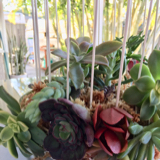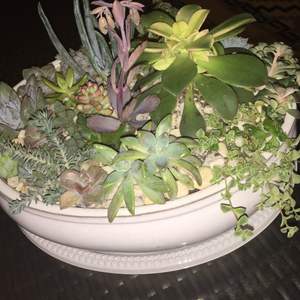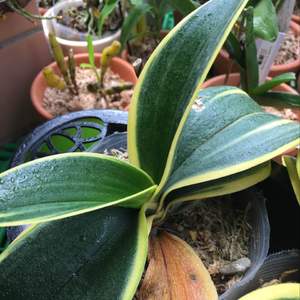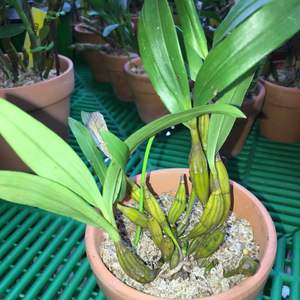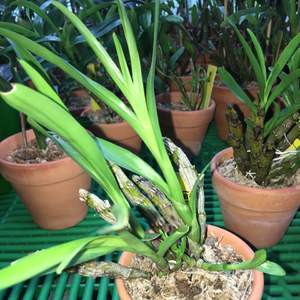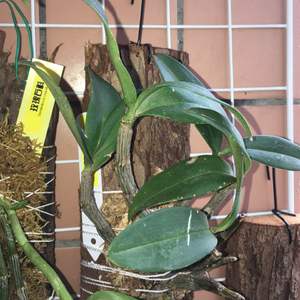文章
Miss Chen
2018年07月09日

Description: This herbaceous perennial plant consists of a rosette of 2-8 basal leaves and a single flowering stalk. The glabrous basal leaves are up to 12" long and ¼" across; they are linear with parallel veins, flattened and solid in cross-section, rather than round and hollow. The basal leaves are rather floppy and often curve downward near the middle, rather than remaining erect. They are green or greyish green, but turn yellow and wither away after the flowers bloom. The flowering stalk is up to 18" long and stiffly erect; it is round or terete and solid in cross-section. This stalk is devoid of cauline leaves and terminates in an umbel of 15-40 flowers that spans about 2" across. Each flower is about ¼" across and consists of 6 white tepals, 6 stamens with conspicuous anthers, and a single slender style. Each tepal may have a line along the middle of its outer/lower surface that is light green, light purple, or light brown. The white filaments of the stamens are narrowly triangular as they become more narrow at their tips where the anthers occur. Each flower has a slender pedicel up to 1" long. At the base of the umbel, there are often 1-3 membranous bracts that originally enclosed the buds of the flowers.
The blooming period occurs from late summer to early fall and lasts about 1 month. The flowers are fragrant. Each flower is replaced by a green seed capsule that is 3-celled and has 3 rounded lobes. Each capsule contains several seeds that are small, black, and shiny. Unlike some Allium spp., no aerial bulbets are produced. The root system consists of an elongated bulb with fibrous roots at the bottom. This plant reproduces by its seeds and vegetative offsets. It often forms clumps of plants.
Cultivation: The preference is full or partial sun, moist to dry conditions, and a rich loamy soil. This plant can spread aggressively by either its seeds or vegetative offsets. Clumps of plants are easily divided and the divided clumps can be planted in new locations. This plant is winter hardy in all areas of Illinois.

Range & Habitat: According to official records, Garlic Chives has not naturalized in Illinois, even though it is often cultivated as a garden plant. This is surprising, considering its aggressive nature. However, the webmaster has observed clumps of naturalized plants that were growing in 3 different locations in the Champaign-Urbana area in Champaign County, Illinois (see Distribution Map). Garlic Chives has naturalized in parts of Wisconsin, Iowa, and Nebraska, and it seems likely that this plant has naturalized in other counties of Illinois as well. It is native to China and parts of SE Asia. So far, habitats in Illinois include a degraded meadow in a wooded area, the bank of a drainage ditch, and the edge of a yard along a sidewalk. Several clumps of Garlic Chives have persisted in the meadow for several years.
Faunal Associations: The nectar of the flowers attracts bees, wasps, flies, butterflies, and skippers. Some of the bees probably collect pollen as well. The foliage has a garlic scent, which is repugnant to many mammalian herbivores. However, young leaves are edible to humans in limited amounts.

Photographic Location: Along a sidewalk in Urbana, Illinois.
Comments: Garlic Chives is often grown in gardens because of its attractive flowers and the culinary properties of the leaves. This plant is fairly easy to identify because it blooms later than other native or naturalized Allium spp., usually in late summer or early fall. The basal leaves of Garlic Chives resemble those of the native Allium cernuum (Nodding Onion), but the latter species has umbels that hang downward and it blooms during mid-summer. The flowering umbels of Garlic Chives resemble those of the native Allium stellatum (Cliff Onion), but the latter has basal leaves that are more narrow and upright. Other Allium spp. differ from Garlic Chives because they bloom earlier in the year, or they produce aerial bulbets, or they have basal leaves that are round and hollow in cross-section.
The blooming period occurs from late summer to early fall and lasts about 1 month. The flowers are fragrant. Each flower is replaced by a green seed capsule that is 3-celled and has 3 rounded lobes. Each capsule contains several seeds that are small, black, and shiny. Unlike some Allium spp., no aerial bulbets are produced. The root system consists of an elongated bulb with fibrous roots at the bottom. This plant reproduces by its seeds and vegetative offsets. It often forms clumps of plants.
Cultivation: The preference is full or partial sun, moist to dry conditions, and a rich loamy soil. This plant can spread aggressively by either its seeds or vegetative offsets. Clumps of plants are easily divided and the divided clumps can be planted in new locations. This plant is winter hardy in all areas of Illinois.

Range & Habitat: According to official records, Garlic Chives has not naturalized in Illinois, even though it is often cultivated as a garden plant. This is surprising, considering its aggressive nature. However, the webmaster has observed clumps of naturalized plants that were growing in 3 different locations in the Champaign-Urbana area in Champaign County, Illinois (see Distribution Map). Garlic Chives has naturalized in parts of Wisconsin, Iowa, and Nebraska, and it seems likely that this plant has naturalized in other counties of Illinois as well. It is native to China and parts of SE Asia. So far, habitats in Illinois include a degraded meadow in a wooded area, the bank of a drainage ditch, and the edge of a yard along a sidewalk. Several clumps of Garlic Chives have persisted in the meadow for several years.
Faunal Associations: The nectar of the flowers attracts bees, wasps, flies, butterflies, and skippers. Some of the bees probably collect pollen as well. The foliage has a garlic scent, which is repugnant to many mammalian herbivores. However, young leaves are edible to humans in limited amounts.

Photographic Location: Along a sidewalk in Urbana, Illinois.
Comments: Garlic Chives is often grown in gardens because of its attractive flowers and the culinary properties of the leaves. This plant is fairly easy to identify because it blooms later than other native or naturalized Allium spp., usually in late summer or early fall. The basal leaves of Garlic Chives resemble those of the native Allium cernuum (Nodding Onion), but the latter species has umbels that hang downward and it blooms during mid-summer. The flowering umbels of Garlic Chives resemble those of the native Allium stellatum (Cliff Onion), but the latter has basal leaves that are more narrow and upright. Other Allium spp. differ from Garlic Chives because they bloom earlier in the year, or they produce aerial bulbets, or they have basal leaves that are round and hollow in cross-section.
0
0
文章
Miss Chen
2018年07月09日

Description: This plant is a biennial. During the 1st year it consists of a small rosette of leaves, while during the 2nd year it becomes a little-branched plant about 1-3' tall. The leaves of 1st year plants are up to 2" long and across. They are cordate-orbicular with margins that are dentate or wavy and their upper surface has a reticulated network of veins. The petioles of these basal leaves are rather long and slender. The alternate leaves of 2nd year plants have a similar appearance, except that they are usually longer than wide, spanning up to 3" long and 2" across. The lower and middle leaves along the stems are usually cordate with either acute or blunt tips, while the upper leaves are often ovate. Both the stems and petioles of 2nd year plants are occasionally hairy, otherwise they are glabrous like the blades of the leaves. The foliage is often light green or yellowish green in appearance, otherwise it is medium green. The upper stems terminate in narrow racemes of white flowers. While in bloom, these flowers are bunched together toward the top of the raceme. However, as the flowers mature and develop seedpods, the raceme becomes more elongated and they become more separated.
Each flower is about ¼" across, consisting of 4 white petals, 4 light green sepals, a short cylindrical style, and several stamens with pale yellow anthers. The pedicels of flowers while they are in bloom are up to ¼" in length, although they become longer later. The blooming period occurs during late spring or early summer, lasting about 1-2 months. The flowers are replaced by narrow seedpods that are called "siliques." These seedpods are about 1½–2" long and narrowly cylindrical (although slightly 4-angled in circumference). Relative to erect stalk of the raceme, they are more or less ascending. As the seedpods become mature, the foliage dies down by the end of summer. Each mature seedpod contains a single row of black oblongoid seeds. The root system consists of a shallow taproot that is white and branches frequently. This plant often forms colonies by reseeding itself.
Cultivation: The preference is partial sun to medium shade, moist to mesic conditions, and a loamy fertile soil. Small rosettes of leaves are formed during the summer of the 1st year, which die down to the ground during the winter. However, during the spring of the following year, new leaves appear on stems that develop rapidly to produce flowers by early summer. This plant is well-adapted to deciduous woodlands and can reseed itself aggressively, forming dense stands that exclude other species. It has few problems with pests and disease organisms.

Range & Habitat: The non-native Garlic Mustard has been reported primarily in NE and central Illinois, where it is locally common. In other areas of the state, this plant is apparently less common or absent, however it is rapidly spreading (see Distribution Map). There is little doubt that it is more common than official records indicate. This plant was introduced into the United States from Eurasia. Habitats include moist to slightly dry deciduous woodlands, woodland borders, areas along woodland paths, semi-shaded areas in gardens and along fence rows, and partially shaded waste areas. This plant thrives in light shade or partial sun and it is intolerant of regular mowing. At the present time, Garlic Mustard is the worst herbaceous invader of deciduous woodlands in Illinois as it has the capacity to crowd out and destroy all of the native wildflowers that bloom during the spring. Effective measures of control include pulling the plants by their roots and spraying the foliage with herbicides. Cutting the flowering stalks from their stems is not an adequate method of control because Garlic Mustard is capable of regenerating new flowering stalks from lateral stems. Also, mature seeds can develop from any cut stalks of flowers and immature seedpods that are left on the ground.

Faunal Associations: The flowers attract various kinds small bees and flower flies. In sunnier areas, they may also attract an introduced butterfly, Pieris rapae (Cabbage White). There appears to be very few native insects that feed on the foliage and other parts of Garlic Mustard. Two flea beetles, Phyllotreta cruciferae and Phyllotreta punctulata, have been reported by Clark et al. (2004) to feed on this plant. These flea beetles also feed on other species in the Mustard family. At the present time, ecologists are examining insect pests of Garlic Mustard in Europe to determine if any of them are suitable for introduction in North America. So far, two species of leaf beetles appear to be the best candidates for biological control. Apparently the seeds are little-used by birds and mammalian herbivores rarely bother the foliage, possibly because they're repelled by its garlic-like scent. Considering how rapidly this plant has spread, it is thought that its seeds cling to the muddy feet of White-tailed Deer and the shoes of humans. This would explain its common occurrence along woodland paths.

Photographic Location: The edge of a deciduous woodland at Judge Webber Park in Urbana, Illinois.
Comments: Garlic Mustard was introduced into the United States as a potherb. The young leaves are edible to humans and quite nutritious – they can be added to salads or boiled in water and seasoned like spinach. The garlic-like aroma of the foliage is quite pronounced, which sets this species apart from many other members of the Mustard family (as well as plants from other families). Some Cardamine spp. (Bitter Cress species) are somewhat similar in appearance to Garlic Mustard, but their foliage lacks a garlic scent and their leaves are usually lobed. Some members of the Mint family have leaves that resemble those of Garlic Mustard, but they differ by having opposite leaves and 4-angled stems; they also lack the elongated seedpods that are typical of both Garlic Mustard and species of Bitter Cress.
Each flower is about ¼" across, consisting of 4 white petals, 4 light green sepals, a short cylindrical style, and several stamens with pale yellow anthers. The pedicels of flowers while they are in bloom are up to ¼" in length, although they become longer later. The blooming period occurs during late spring or early summer, lasting about 1-2 months. The flowers are replaced by narrow seedpods that are called "siliques." These seedpods are about 1½–2" long and narrowly cylindrical (although slightly 4-angled in circumference). Relative to erect stalk of the raceme, they are more or less ascending. As the seedpods become mature, the foliage dies down by the end of summer. Each mature seedpod contains a single row of black oblongoid seeds. The root system consists of a shallow taproot that is white and branches frequently. This plant often forms colonies by reseeding itself.
Cultivation: The preference is partial sun to medium shade, moist to mesic conditions, and a loamy fertile soil. Small rosettes of leaves are formed during the summer of the 1st year, which die down to the ground during the winter. However, during the spring of the following year, new leaves appear on stems that develop rapidly to produce flowers by early summer. This plant is well-adapted to deciduous woodlands and can reseed itself aggressively, forming dense stands that exclude other species. It has few problems with pests and disease organisms.

Range & Habitat: The non-native Garlic Mustard has been reported primarily in NE and central Illinois, where it is locally common. In other areas of the state, this plant is apparently less common or absent, however it is rapidly spreading (see Distribution Map). There is little doubt that it is more common than official records indicate. This plant was introduced into the United States from Eurasia. Habitats include moist to slightly dry deciduous woodlands, woodland borders, areas along woodland paths, semi-shaded areas in gardens and along fence rows, and partially shaded waste areas. This plant thrives in light shade or partial sun and it is intolerant of regular mowing. At the present time, Garlic Mustard is the worst herbaceous invader of deciduous woodlands in Illinois as it has the capacity to crowd out and destroy all of the native wildflowers that bloom during the spring. Effective measures of control include pulling the plants by their roots and spraying the foliage with herbicides. Cutting the flowering stalks from their stems is not an adequate method of control because Garlic Mustard is capable of regenerating new flowering stalks from lateral stems. Also, mature seeds can develop from any cut stalks of flowers and immature seedpods that are left on the ground.

Faunal Associations: The flowers attract various kinds small bees and flower flies. In sunnier areas, they may also attract an introduced butterfly, Pieris rapae (Cabbage White). There appears to be very few native insects that feed on the foliage and other parts of Garlic Mustard. Two flea beetles, Phyllotreta cruciferae and Phyllotreta punctulata, have been reported by Clark et al. (2004) to feed on this plant. These flea beetles also feed on other species in the Mustard family. At the present time, ecologists are examining insect pests of Garlic Mustard in Europe to determine if any of them are suitable for introduction in North America. So far, two species of leaf beetles appear to be the best candidates for biological control. Apparently the seeds are little-used by birds and mammalian herbivores rarely bother the foliage, possibly because they're repelled by its garlic-like scent. Considering how rapidly this plant has spread, it is thought that its seeds cling to the muddy feet of White-tailed Deer and the shoes of humans. This would explain its common occurrence along woodland paths.

Photographic Location: The edge of a deciduous woodland at Judge Webber Park in Urbana, Illinois.
Comments: Garlic Mustard was introduced into the United States as a potherb. The young leaves are edible to humans and quite nutritious – they can be added to salads or boiled in water and seasoned like spinach. The garlic-like aroma of the foliage is quite pronounced, which sets this species apart from many other members of the Mustard family (as well as plants from other families). Some Cardamine spp. (Bitter Cress species) are somewhat similar in appearance to Garlic Mustard, but their foliage lacks a garlic scent and their leaves are usually lobed. Some members of the Mint family have leaves that resemble those of Garlic Mustard, but they differ by having opposite leaves and 4-angled stems; they also lack the elongated seedpods that are typical of both Garlic Mustard and species of Bitter Cress.
0
0
文章
Miss Chen
2018年07月08日

Description: This herbaceous perennial plant is 1-2½' tall, consisting of basal leaves and flowering stalks with alternate leaves. The stalks are light green and glabrous. The basal and lower leaves are bipinnate with 6-9 leaflets, while the upper leaves are pinnate with 3 leaflets. When the leaves are bipinnate, they are ternately divided into 3 groups of leaflets (2 lateral groups & a terminal group); each group has 2-3 leaflets. The leaflets of basal and lower leaves are 2-3" long and 1¼-2" across; they are medium to dark green, more or less ovate in shape, serrate or doubly serrate along their margins, and hairless or nearly so. Some leaflets may be deeply cleft into two lobes. The leaflets of upper leaves are smaller in size and more narrow in shape (lanceolate or oblong-lanceolate), otherwise they are similar to the leaflets of the preceding leaves. The petioles of basal and lower leaves are 4-12" long, while the petioles of upper leaves are less than 4" long. These petioles are light green and hairless; the petioles of alternate leaves are sheathed at their bases. The petiolule (basal stalklet) of the terminal group of leaflets is 2-3" long, while the petiolules of the lateral groups of leaflets are about 1" long. In each group of leaflets, the lateral leaflets are sessile or nearly so, while the terminal leaflet has a secondary basal stalklet that is nearly sessile to 1" long.
The stalks terminate in compound umbels of flowers about 1½-3½" across that are flat-topped. Each compound umbel is divided into 10-20 umbellets, while each umbellet is divided into 10-25 flowers. The compound umbels lack floral bracts and the umbellets lack floral bractlets. Individual flowers are about 1/8" (3 mm.) across, consisting of 5 white petals with incurved tips and an inferior ovary with a pair of styles. The peduncles of the compound umbels are 3-6" long, light green, glabrous, angular, and grooved. The pedicels of individual flowers are about ¼" in length, light green, and glabrous. The blooming period occurs from late spring to mid-summer, lasting about 1 month. The flowers are replaced by ovoid-oblongoid fruits that are ridged and somewhat flattened; they are about 1/8" (3 mm.) long and release their seeds at maturity during the autumn. The root system is fibrous and rhizomatous. Goutweed often forms clonal colonies from the spreading rhizomes.

Cultivation: The preference is partial sun to light shade, moist to mesic conditions, and soil containing loam, clay-loam, or sandy loam. This plant has few problems with either insects or disease organisms. It can spread aggressively, particularly in locales with cool moist climates.

Range & Habitat: So far, Goutweed has rarely escaped from cultivation and become naturalized in Illinois. It has been found as an escaped plant in only a few counties of NE Illinois (see Distribution Map). Because of its aggressive nature, Goutweed may become more common in the future. It was introduced into North America from Eurasia as an ornamental plant. Habitats include deciduous woodlands (sandy & non-sandy), shaded ravines, woodland borders, cemeteries, roadsides, and waste areas. Cultivated forms of Goutweed include those with variegated and non-variegated leaves. However, wild specimens of Goutweed almost always have non-variegated leaves.
Faunal Associations: Floral-faunal relationships for this plant in North America are poorly understood. Müller (1873/1883) observed miscellaneous flies, beetles, wasps, small bees, and sawflies visiting the flowers for either nectar or pollen in Germany. Apparently the young foliage of Goutweed is considered edible to humans as it has been used in the Old World as a source of food and a medicinal herb.

Photographic Location: A flower garden in Urbana, Illinois.
Comments: Like many other species in the Carrot family, Goutweed has compound umbels of small white flowers and compound leaves. It can be identified by the absence of floral bracts and bractlets underneath its flowers, and by the structure and shape of its leaves. Generally, its compound leaves have ternately arranged leaflets (divided into groups of 3), although the leaflets within a group sometimes occur in pairs. Compared with many other species in the Carrot family, these leaflets are relatively large in size and relatively broad in shape when one considers the size of the plant. Among native wildflowers, Honewort (Cryptotaenia canadensis) is similar in appearance to Goutweed, but the flowers of Honewort are even smaller in size and its compound leaves have only 3 leaflets, rather than 3 groups of leaflets.
The stalks terminate in compound umbels of flowers about 1½-3½" across that are flat-topped. Each compound umbel is divided into 10-20 umbellets, while each umbellet is divided into 10-25 flowers. The compound umbels lack floral bracts and the umbellets lack floral bractlets. Individual flowers are about 1/8" (3 mm.) across, consisting of 5 white petals with incurved tips and an inferior ovary with a pair of styles. The peduncles of the compound umbels are 3-6" long, light green, glabrous, angular, and grooved. The pedicels of individual flowers are about ¼" in length, light green, and glabrous. The blooming period occurs from late spring to mid-summer, lasting about 1 month. The flowers are replaced by ovoid-oblongoid fruits that are ridged and somewhat flattened; they are about 1/8" (3 mm.) long and release their seeds at maturity during the autumn. The root system is fibrous and rhizomatous. Goutweed often forms clonal colonies from the spreading rhizomes.

Cultivation: The preference is partial sun to light shade, moist to mesic conditions, and soil containing loam, clay-loam, or sandy loam. This plant has few problems with either insects or disease organisms. It can spread aggressively, particularly in locales with cool moist climates.

Range & Habitat: So far, Goutweed has rarely escaped from cultivation and become naturalized in Illinois. It has been found as an escaped plant in only a few counties of NE Illinois (see Distribution Map). Because of its aggressive nature, Goutweed may become more common in the future. It was introduced into North America from Eurasia as an ornamental plant. Habitats include deciduous woodlands (sandy & non-sandy), shaded ravines, woodland borders, cemeteries, roadsides, and waste areas. Cultivated forms of Goutweed include those with variegated and non-variegated leaves. However, wild specimens of Goutweed almost always have non-variegated leaves.
Faunal Associations: Floral-faunal relationships for this plant in North America are poorly understood. Müller (1873/1883) observed miscellaneous flies, beetles, wasps, small bees, and sawflies visiting the flowers for either nectar or pollen in Germany. Apparently the young foliage of Goutweed is considered edible to humans as it has been used in the Old World as a source of food and a medicinal herb.

Photographic Location: A flower garden in Urbana, Illinois.
Comments: Like many other species in the Carrot family, Goutweed has compound umbels of small white flowers and compound leaves. It can be identified by the absence of floral bracts and bractlets underneath its flowers, and by the structure and shape of its leaves. Generally, its compound leaves have ternately arranged leaflets (divided into groups of 3), although the leaflets within a group sometimes occur in pairs. Compared with many other species in the Carrot family, these leaflets are relatively large in size and relatively broad in shape when one considers the size of the plant. Among native wildflowers, Honewort (Cryptotaenia canadensis) is similar in appearance to Goutweed, but the flowers of Honewort are even smaller in size and its compound leaves have only 3 leaflets, rather than 3 groups of leaflets.
0
0







